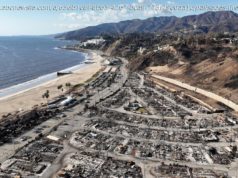Officials in South Carolina confirmed the state’s first fatality from the still dangerous Tropical Storm Florence, bringing the storm’s total death toll to at least…
Officials in South Carolina confirmed the state’s first fatality from the still dangerous Tropical Storm Florence, bringing the storm’s total death toll to at least seven so far.
Police said a 62-year-old woman was killed late Friday when the vehicle she was driving struck a tree that had fallen across Highway 18 near the town of Union.
Capt. Kelly Hughes of the South Carolina Highway Patrol said the woman, who was wearing a seat belt, died at the scene and no passengers were in the vehicle at the time.
Authorities in North Carolina have confirmed multiple deaths. Early Saturday, the state tally fluctuated when officials initially counted, then subtracted, two deaths now thought to have been the result of a murder-suicide during the storm. That case is under investigation.
Mandatory evacuations were issued for areas surrounding the banks of Cape Fear River in North Carolina.
The National Hurricane Center said on Saturday afternoon that “catastrophic flooding” is expected in certain parts of the Carolinas.
Florence parked itself over the Carolinas on Saturday, bringing with it torrential downpours, dangerous winds and coastal flooding that required hundreds of water rescues and ended in multiple deaths.
“It’s like being stalked by a turtle,” FEMA associate director Jeffrey Byard said about the slow-moving storm. “There’s a lot of rain to come. There’s a lot of rain that’s fallen.”
Emergency workers have been going door to door in North Carolina, pleading with people who have chosen to ride out the storm to leave.
“I cannot overstate it: Floodwaters are rising, and if you aren’t watching for them, you are risking your life,” North Carolina Gov. Roy Cooper said Saturday.
More than 2 feet of rain over the course of 24 hours has fallen in some places in North Carolina, with forecasters calling for an additional 1½ feet by the end of the weekend. The fear is that flash flooding could devastate communities, endanger dams and block bridges. The storm also knocked out power to nearly a million people.
Aerial photos along the coast near New Bern showed homes floating in water and rescuers racing to reach the people who were trapped inside.
“The fact is, this storm is deadly and we know we are days away from an ending,” he said.
Among those killed by Florence are a mother and her 8-month baby, who were crushed when a tree fell on their house. The father was trapped inside for hours but first responders were able to get him out and take him to the hospital.
In a separate occurrence, a 77-year-old man was knocked down by the wind and died after going out to check on his hunting dogs, Lenoir County authorities said. The governor’s office said another man was electrocuted while trying to connect extension cords in the rain.
Since Thursday, more than 360 people have been carried to higher ground amid rising waters from a river swelled by both rain and salty storm surge.
New Bern, North Carolina, Mayor Dana Outlaw urged residents not to return just yet.
“We have a lot of downed power lines,” he told Fox News. “We’re very concerned with these energized lines and folks could get hurt. So give the city time to get out and assess our infrastructure and get the roads safe for you to travel.”
Shaken after seeing waves crashing on the Neuse River just outside his house in New Bern, restaurant owner and hurricane veteran Tom Ballance wished he had evacuated.
“I feel like the dumbest human being who ever walked the face of the earth,” he said.
Since it’s roared ashore, Florence has flattened trees, buckled buildings and crumpled roads. Storm surges — the bulge of ocean water pushed ashore by the hurricane — were as high as 10 feet.
Florence peaked at a Category 4 with top winds of 140 mph over warm ocean water before making landfall as a Category 1. It blew ashore along a mostly boarded-up, emptied-out stretch of coastline.
By midmorning Saturday, Florence lazily inched its way about 40 miles west of Myrtle Beach, South Carolina at 2 mph – slower than most humans walk.
“It’s like being stalked by a turtle,” FEMA associate director Jeffrey Byard said about the slow-moving storm. “There’s a lot of rain to come. There’s a lot of rain that’s fallen.”
South Carolina Rep. Tom Rice described the storm to Fox News as a “slow poison.”
Florence’s devastation has less to do with wind and more to do with water.
Morehead City, North Carolina, had received 23 inches of rain by Friday night, and forecasters warned Saturday morning that parts of the Carolinas could get up to 15 inches more.
At times, Florence was moving forward no faster than a human can walk, and it has remained such a wide storm that its counter-clockwise winds keep scooping up massive amounts of moisture from the sea. The flooding began on barrier islands in North Carolina and then spread into coastal and river communities there and in South Carolina, swamping the white sands and golf courses in North Myrtle Beach.
For people living inland in the Carolinas, maximum peril could come days later as all that water drains, overflowing rivers and causing flash floods.
Authorities warned, too, of risks of mudslides and environmental disasters from floodwaters washing over industrial waste sites and hog farms.
About 9,700 National Guard troops and civilians were deployed with high-water vehicles, helicopters and boats.
Florence could become a major test for the Federal Emergency Management Agency, which was heavily criticized as slow and unprepared last year for Hurricane Maria in Puerto Rico, where the death toll was put at nearly 3,000.
The hurricane center said the storm will eventually break up over the southern Appalachians and make a right hook to the northeast, its rainy remnants moving into the Mid-Atlantic states and New England by the middle of next week.
Meteorologist Ryan Maue, of weathermodels.com, calculated that Florence could dump a staggering 18 trillion gallons of rain over a week on North Carolina, South Carolina, Virginia, Georgia, Tennessee, Kentucky and Maryland. That’s enough to fill the Chesapeake Bay or cover the entire state of Texas with nearly 4 inches of water.
North Carolina alone is forecast to get 9.
Домой
United States
USA — Events Torrential rain from Hurricane Florence causing ‘catastrophic flooding’






